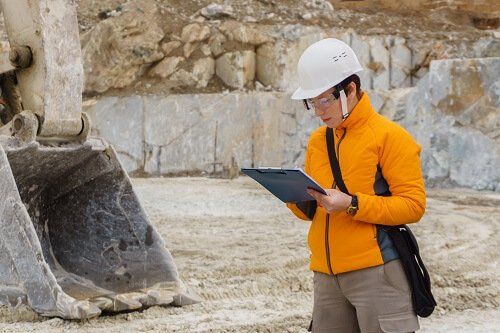Slope monitoring: Current challenges and delving deeper
E&MJ investigates the drivers behind the host of new geotechnical monitoring products that have launched this year. This is an excerpt from an article by Carly Leonida based on an interview with AMC’s Senior Geotechnical Engineer, Meredith Goss.
Successful slope stability design is, and has always been, dependent on striking the correct balance between an acceptable level of stability and optimizing the economic extraction of an orebody. To achieve this requires expert input early on in a project, adequate geotechnical data and sufficient slope stability analyses to justify the mine design.
Australia-based consultancy firm, AMC Consultants, has deep expertise in slope analysis and design. Meredith Goss from AMC’s geotechnical team in Melbourne, spoke to E&MJ about some of the challenges facing open-pit operators today.
“Due to project economics, geotechnical engineers are often expected to give aggressive slope designs using a very limited amount of data,” she explained. “Mine designs can be exposed to risk due to low confidence in the geotechnical data, and often there is little attention paid to hydrogeology in the initial stages of design.
“It is necessary to obtain a balance between an optimal mine design based on economics and allowing for contingency, that is, having some flexibility available to adjust the bench configuration in the mine design in the event of unexpected ground conditions. Slope design does not stop at the project stage, but geotechnical data collection (drilling, mapping, data processing, and monitoring) needs to continue throughout the operational life of the mine, and the data needs to be incorporated in the pit design and mine planning process.”
Goss noted that mine operators have become more aware of the risks associated with slope stability in recent years, however, this is often dependent upon the size of the operation.

She added that finding and employing experienced geotechnical engineers for site-based roles remains one of the greatest challenges that mines face. As such, geologists are often required to complete routine geotechnical data collection and processing in addition to their other duties. This makes digital data collection systems that can present accurate and timely data in an easy-to-read format all the more valuable.
“The capability of monitoring systems on the market is continually improving, especially for monitoring larger scale displacements,” she said. “It is necessary to get the correct proportions of knowledgeable people on the ground, machine monitoring, data collection, and analyses to understand the rock mass conditions.
“Generally, the use of expensive monitoring equipment is driven by economics, for example, economic gains brought about by having steeper pit walls will pay for a radar, or a rock fence. The challenge is ensuring the data is communicated through the business and mine planning process.”
The AMC geotechnical team works with mine operators to develop a proactive approach to identifying and managing geotechnical issues. The company has particular expertise in the analysis and interpretation of ground conditions to develop geotechnical models, integrating slope-stability analysis, numerical modelling, sound open-pit design and geotechnical risk management.
“AMC maintains an extensive and up-to-date Smart Data System of mining costs and productivities for surface and underground mines. The system is recognized as the world’s largest, most comprehensive suite of validated, site-level performance benchmarking data set available, for mining,” Goss stated proudly.
To date, AMC has completed more than 60 detailed open-pit benchmarking studies worldwide, including productivity and cost benchmarking. Most of the studies conducted during the past year were for return clients that rely on AMC to provide independent accurate benchmarking information. The company’s methodology allows the comparison of a site’s performance to a cross-section of comparable operations, helping them to achieve superior results.
Mines delve deeper
SAMC also assists clients with reviewing current slope designs, continuous improvement, benchmarking studies to establish the exposure to risk, and evaluating the economics of mining deeper pits or heading underground.
As pits become deeper the economic drivers for steeper slopes become more significant, and it becomes much harder to include conservatism or flexibility in the design to allow for unforeseen changes in geotechnical conditions. The aggressive slope design angles which are often adopted to make deep pits economically viable increase rockfall risk through crest loss, filling of berms, increased frequency of rockfalls, and slope failure.
Prism monitoring systems are generally ineffective for rockfall monitoring, and across large pits radars generally lack the resolution to predict large rockfall events. This is especially true where vertical or sub-vertical batters have been mined.
As depth increases, stress increases, and this is likely to result in some level of micro-seismicity and rock mass damage. Hydrogeological conditions are often not well understood but can have a significant effect on slope stability. As pits become deeper, groundwater conditions within pit slopes also have more influence on stability. Towards the base of the pit floor, space can be at a premium and ancillary activities such as drilling dewatering holes will often get pushed aside in favour of production-based activities like drilling and blasting and/or haulage.
So, how can engineers determine the safe depth limit for an open pit and whether to continue mining from the surface or head underground?
Goss explained: “There is no defined safe depth limit for an open pit. The decision to head underground is affected by economic and safety risk, and the size and shape of the orebody.”
Again, this serves to emphasize the need for a reliable and robust monitoring system. However, as with many decisions, the cost of monitoring needs to be justified.
“Not everyone is going to be able to afford a radar,” said Goss. “The cost must be weighed against the potential benefits of managing the geotechnical risks, e.g. rockfalls, structural failure or overall wall failure. How fast is a failure likely to occur – hours, weeks or months?
“Different monitoring systems will be more or less effective depending on the anticipated rate and mode of failure. Understanding the limitations or blind spots for each monitoring technology is important. The monitoring system should comprise of several technologies that can be combined to give an overall picture of what is occurring.”
It is necessary to consider whether the monitoring system will send alarms for operational hazard management, in which case real-time data collection and continuous radio/telecommunication links are required. Alternatively, the system may be intended to collect background information that helps better understand the geotechnical behaviour of the mine. Accessibility and reliability are key considerations, particularly in large pits, as access along benches and berms is often restricted and there may be no access for personnel to install instruments or collect data, and a remote method may be required.
Goss told E&MJ that AMC is also seeing more requests for assistance from mines with aging infrastructure and long lives remaining.
“The requests include reviewing current slope designs and providing advice on management of ground conditions, while finding opportunities to implement new world-class technologies which will optimize the mines for the future,” she explained. “The AMC team works collaboratively with mine personnel, undertaking a logical and phased sequence of mining support services with practical mining method solutions and technologies.”
AMC acknowledges the contributions of Adrian Penney, Mathew Widelski, Johann van Wijk, and Asoka Herath to this article.
Subscribe for the latest news & events
Contact Details
Useful Links
News & Insights

